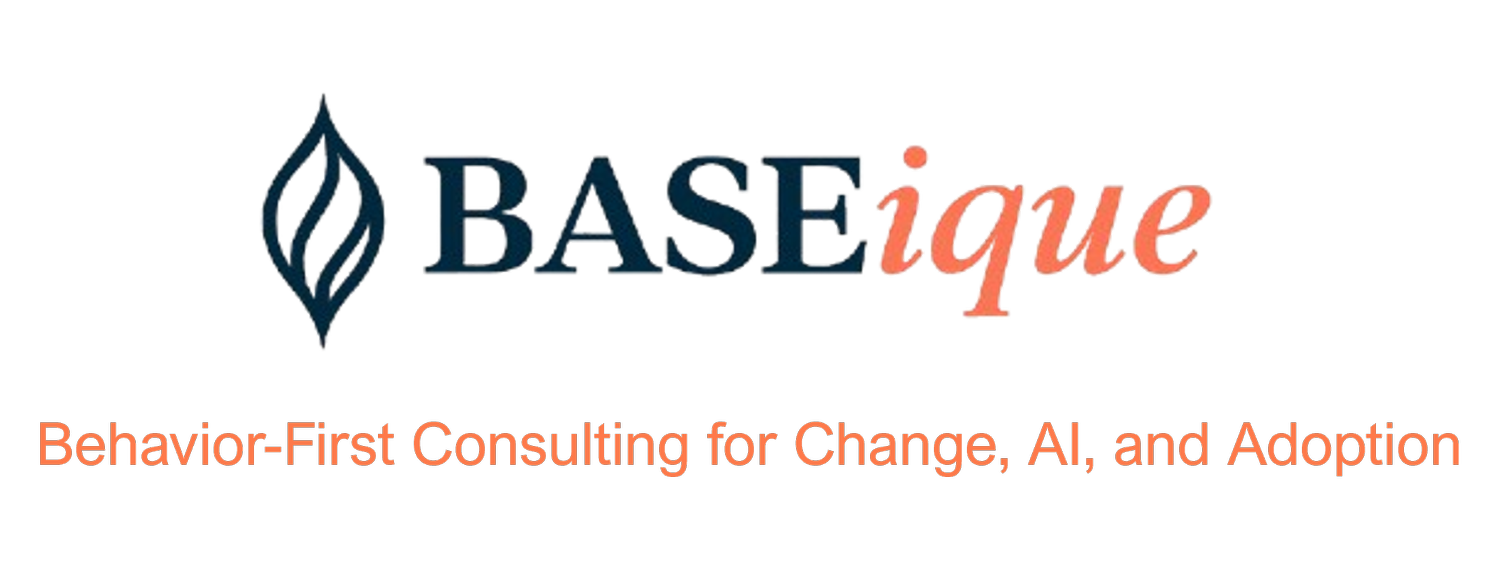What the B.A.S.E. Method is and why it exists
“You don't fix broken systems by adding more tools. You fix them by clearing the path.”
I’ve worked with organizations across healthcare, SaaS, and enterprise tech. The industry changes, but the core problem stays the same: It’s not the people. It’s the friction.
It sounds like:
Great work going nowhere
Talented teams running in circles
Strategies collecting dust
Everyone owning part of the work. No one owning the outcome.
These aren’t people problems. They’re system design problems.
Transformation doesn’t fail because of the tech. It fails in the gap between strategy and people-centered execution.
So, I built something to solve that. Because duct tape and optimism will only get you so far.
Why Behavior Matters
Most change efforts are top-down and tool-first. They chase innovation without fixing foundational issues like intake, communication, and handoffs.
That’s where behavior comes in. It’s the real driver of adoption, alignment, and flow.
I come from a background in mental health counseling. It taught me that the best solution in the world won’t land if it ignores how people think, feel, and move through systems.
That insight has shaped how I lead operations and transformation work across industries. It also led me to develop the B.A.S.E. Method, a behavior-first approach to turning strategy into action.
What Happens If You Don’t Fix It
High performers quietly check out
Teams stop trusting the process
Resistance builds faster with every rollout
Your tools turn into graveyards of good intentions
The B.A.S.E. Method: What It Stands For
B — Begin with Behavior. Start with how people currently operate, not how you wish they did. Where do they drop off? Skip steps? Create workarounds?
This step is grounded in behavioral observation, not just process mapping, to uncover hidden friction.
A — Align with Motivation. Design around the reasons people take (or avoid) action. What are they incentivized to do? What’s confusing or draining?
Change becomes easier when systems work with human tendencies instead of against them.
S — Simplify the System. Remove friction. Make workflows intuitive, steps obvious, and tools easy to use. Less effort = more adoption.
This is where behavioral economics comes into play. Defaults, nudges, and clarity reduce decision fatigue and make good behavior the easy choice.
E — Enable with Communication. Support change with language people truly understand. Communicate early and often. Clear expectations. Role-based messaging. Human-first rollout plans.
Borrowing from behavior change theory, this focuses on timing, repetition, and trust-building to reduce resistance.
The Results
High adoption of new tools, processes, and initiatives
Improved cross-functional clarity and reduced rework
Rebuilt trust in systems after burnout or change fatigue
Structure people will actually use
How B.A.S.E. Compares to Traditional Change Models
You may be familiar with models like Prosci’s ADKAR®, which walk individuals through the stages of personal change: awareness, desire, knowledge, ability, and reinforcement.
The B.A.S.E. Method complements those models but tackles a different piece of the puzzle.
Instead of starting with individual mindset, B.A.S.E. starts with system behavior. It asks: Where are people dropping off? What’s creating resistance? How do we reduce friction in the workflow itself?
Change doesn’t fail at the intent level. It fails in the design.
B.A.S.E. gives you a way to address that by aligning systems with how people actually think, move, and work.
Real Example
A cross-functional team I worked with had been struggling with low adoption of a new intake process. Requests were getting lost, and frustration was growing.
We started by observing how people were using the system. Turns out, most were bypassing it entirely. They were sending emails or building side spreadsheets instead. Why? Because the intake form was buried in a folder and took 12 clicks to complete.
Using behavioral insights, we simplified the intake, clarified ownership, and aligned it to how teams already worked. Within a month, usage jumped 70%, and duplicate requests dropped.
The fix wasn’t flashy. It was behavioral.
Those same insights became the foundation of the B.A.S.E. Method. It's the framework I use to guide change across teams and tools.
I’ve followed these principles for years. I just didn’t have a name for them until now.
Who It’s For
If you're leading transformation and dealing with:
Resistance to new systems
Chaotic intake or unclear handoffs
Tools that nobody uses
Teams putting in effort with no visible progress
Lack of insight into capacity
This isn’t a talent problem. It’s a friction problem.
The B.A.S.E. Method clears the path, so progress is possible.
The Bottom Line
I created the B.A.S.E. Method to solve a problem I saw everywhere, like glitter at a preschool art table. It blends what I know from behavior change with what I’ve seen leading cross-functional teams and enabling strategic delivery in complex environments.
This isn’t about innovation theater. It’s about outcomes people can feel, like clarity, momentum, and work that finally moves.
“When your team is running hard, but nothing is moving, the answer isn't more effort. It's less friction.”
If you're stuck in the gap between strategy and execution, let’s talk! I built B.A.S.E. to bridge exactly that.
